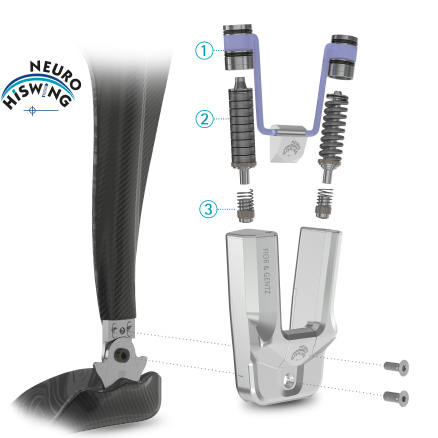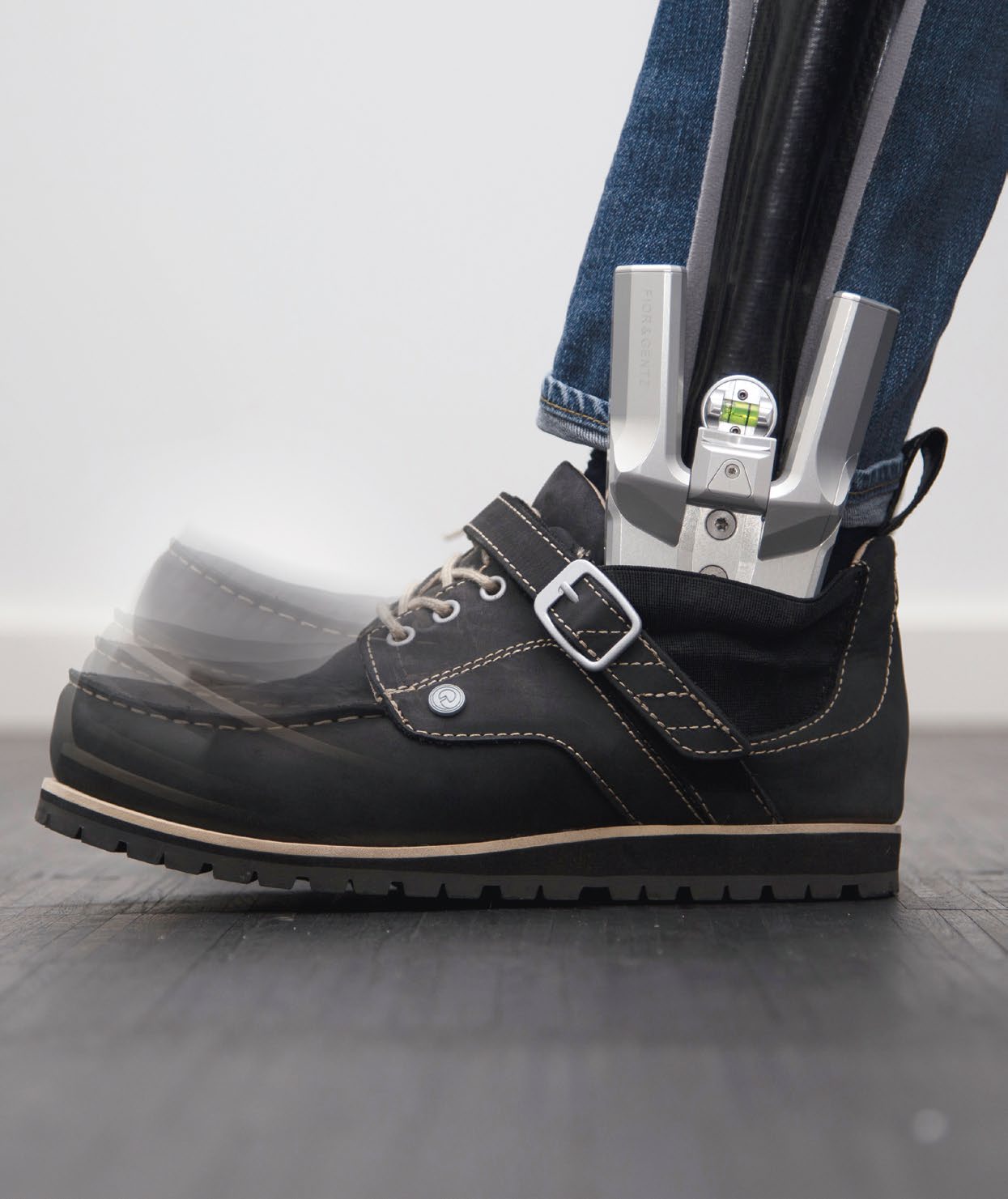The adjustable Neuro Swing system ankle joint from Fior & Gentz is fast becoming a preferred solution to aid the rehabilitation of patients with a neurological condition such as stroke, MS, brain injury and peripheral neuropathy.
The Neuro Swing system enables us to return the patient’s gait pattern to one that is as near normal as possible. By doing this we are also protecting bones and joints and encouraging muscles to work correctly. At LOC we have the advantage of being able to fine-tune the Neuro Swing system in our Gait Lab.
The Neuro Swing AFO has a unilateral ankle joint that is designed to be held within a carbon fibre construction. The joint has two springs, posterior and anterior. The springs can be altered in three ways. Resistance in the springs can be reduced or increased and the range of movement can be altered as can the alignment of the ankle.
The NEURO HiSWING is the latest innovation in AFO technology from Fior & Gentz. It is an exciting development of their Neuro Swing AFO which LOC already prescribes to many patients with neurological conditions. This enhancement means that stairs and even hilly terrains can easily be mastered.
The hydraulic valve allows the wearer to independently change the angle of the ankle joint. This has the following benefits:

image courtesy of Fior & Gentz

image courtesy of Fior & Gentz
For example, if a patient presents with a reduced range of movement and a poor gait pattern due to muscle weakness, we can tune the ankle joint to stretch the affected joint and strengthen the adjoining muscles as well. The joint can be adjusted to change the range of movement over time as the patient improves. If however, a patient presents with some active range of movement, the ability to move their ankle, for example, we want them to use their own muscles to control that movement whereas traditional fixed AFOs would block both good and bad movement.
We work closely with our patient’s physiotherapist and the Neuro Swing system allows tremendous flexibility to respond to an individual’s existing balance, gait and strength, so we can really optimise their walking pattern. Moreover, as the patient progresses and improves during their rehabilitation the springs of the Neuro Swing ankle joint can be continuously adjusted, being adapted and evolving to reflect the patient’s improvement. Our patients love it!
LOC is very grateful to FIOR & GENTZ, Lunenberg, for their permission to use the animated video about the Neuro Swing:
An AFO is an Ankle Foot Orthosis which as the name would suggest encompasses the ankle and foot. The objective is to control the position and movement of the ankle. AFOs are used to support weak limbs; they can also be used to immobilise the ankle and lower leg to correct foot drop. When set up correctly they can also have a great influence on the knee and hip joints. They are the most commonly used Orthoses.
The length of time that one needs to wear an AFO very much depends on the condition being treated. If it is a long-term condition like cerebral palsy or post-polio syndrome it is likely to be years as the condition cannot be cured. Your orthotist will advise you.
A patient’s comfort in their AFO is vital for compliance with the prescribed wearing regime.
So there are a number of steps the orthotist should take to ensure a comfortable fit: the patient’s heel should fit fully into the heel cup without excess space, the contours of the plantar surface of the AFO should match the patient’s foot, for children there needs to be up to half an inch growth room in the toe shelf length. At LOC we use our Gait Laboratories at our Kingston and Manchester clinics to fine-tune our bespoke orthotics.
A GRAFO is used to control instabilities in the lower limb by maintaining proper alignment of limbs and controlling their motion. It reaches around to the front of the knee extending down to the ankle. It works by altering a patient’s limb presentation to displace load and impact as well as offering further control to the knee.
The cost of an AFO is dependent on the type of AFO that has been prescribed and the material that it has been made with. Carbon fibre will be more expensive than metal or plastic for example. LOC’s bespoke AFOs cost can be found on our Orthotic Prices page.
The ability to drive while wearing an AFO is dependent on the condition being treated and the orthosis that has been prescribed. If wearing a hinged AFO, for example, you will be able to drive, but if wearing a knee brace, you won’t. Your orthotist will advise you.
The most flexible type of AFO is a Dynamic Ankle Foot Orthosis (DAFO). It is thin and provides flexible support to the foot and ankle.
Both normal AFOs and DAFOs improve static balance (eg: while standing). Research among MS sufferers suggests that DAFOs aided balance while walking more than AFOs.
The simple answer is: yes they can. However one has to be sensible and look for wide-fitting trousers/jeans preferably of light and thin material.
Typically an AFO is stiff and rigid whereas a DAFO is thin, flexible and wraps around the patient’s entire foot. A DAFO provides support but also allows some range of normal movement.
A Supra Malleolar Orthosis SMO gets its name from the part of the body it encompasses. Thus an SMO supports the leg just above the ankle bone or malleoli. It allows dorsiflexion and plantar flexion(toes up and toes down) but eliminates mediolateral movement.
It typically takes a few weeks but is slightly dependent on the chosen materials and current availability.

Join The London Orthotic Consultancy in celebrating Cerebral Palsy Awareness Day on March 25th. Learn just how important expert orthotic care is in enhancing mobility, independence, and quality of life for children and adults with cerebral palsy.

Introducing the Agilik™ smart orthosis, a cutting-edge, powered knee orthotic now available in the UK through the London Orthotic Consultancy. Unlike traditional KAFOs or heavy exoskeletons, the Agilik™ provides dynamic knee assistance and offers real-time support, reducing fatigue and improving posture. This pioneering, modern technology can help children and adults with lower limb weakness walk more efficiently and naturally. We are honoured to be selected as the exclusive paediatric specialist centre in the UK for the Agilik™ device.

When Sophie noticed her baby Max had a persistent flat spot on his head, she was told it would resolve naturally—but it didn’t. Seeking a second opinion led her to the London Orthotic Consultancy, where Max was diagnosed with severe plagiocephaly.

A little more than four years after the LOCband Lite's launch, we're proud to have successfully treated our 250th helmet therapy patient at our Romford clinic using our cutting-edge 3D-printed cranial band. After five months of treatment, her final scan showed that her asymmetry had decreased from 12 mm to 3 mm.

Sky News published an article this month quoting scientists at Southmead Hospital who claimed there was a lack of research into flat head syndrome and its treatment with cranial remoulding (helmet) therapy. This is our response.

With our non-surgical treatment plan, Alex achieved 100% chest correction in just two years. His treatment involved a combination of dynamic chest compressor and vacuum bell therapy treatment to address his pectus excavatum and rib flaring.

Learn how a custom carbon fibre AFO helped Gill regain mobility and comfort despite complex challenges from shin bone (tibia) removal. We created a truly tailored orthotic solution made from pre-preg carbon fibre at our Cambridge clinic.

Discover how bespoke orthotics and the OSKAR program with Elaine Owen transformed Archie’s life with cerebral palsy quadriplegia, helping him avoid a wheelchair and achieve greater mobility.